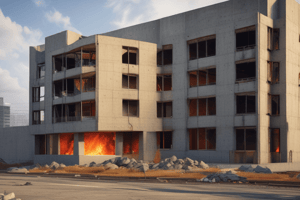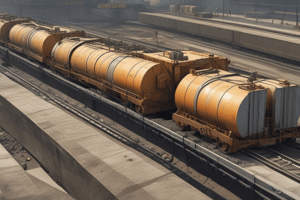Podcast
Questions and Answers
What primarily causes spalling in concrete exposed to fire?
What primarily causes spalling in concrete exposed to fire?
- Cracking from thermal expansion
- Water turning to steam within the concrete (correct)
- Chemical reactions within the concrete mix
- Inadequate curing of the concrete
Why are lower floors of a building typically unoccupied during construction?
Why are lower floors of a building typically unoccupied during construction?
- They are usually more costly to rent
- They serve as storage areas for construction materials (correct)
- Building codes require them to remain empty until completion
- They have insufficient access for construction crews
Which of the following statements about sprinkler installation is most accurate?
Which of the following statements about sprinkler installation is most accurate?
- Sprinklers are installed on lower floors due to higher fire risk
- Sprinklers are required on all floors regardless of occupancy
- the upper floors being finished and occupied must have operational sprinklers
- Install a basic , exposed pipe sprinkler system with 1in outlets for lower floors (correct)
What factor is crucial in reducing the chances of spalling in heated concrete?
What factor is crucial in reducing the chances of spalling in heated concrete?
What is a reasonable consideration when installing a sprinkler system in a new building?
What is a reasonable consideration when installing a sprinkler system in a new building?
What key factor contributed to the effective design of the sprinkler system in the high-rise building referenced?
What key factor contributed to the effective design of the sprinkler system in the high-rise building referenced?
What is one of the main challenges firefighters face regarding occupied buildings under construction?
What is one of the main challenges firefighters face regarding occupied buildings under construction?
Why might the practice of allowing occupancy during construction be seen as acceptable in smaller homes?
Why might the practice of allowing occupancy during construction be seen as acceptable in smaller homes?
What is a proposed measure to ensure safety when fire protection systems are not fully operational in buildings?
What is a proposed measure to ensure safety when fire protection systems are not fully operational in buildings?
What is one consequence of blocking stairwell doors during construction?
What is one consequence of blocking stairwell doors during construction?
Which factor contributes to the rapid spread of fire in buildings under construction?
Which factor contributes to the rapid spread of fire in buildings under construction?
What factor most significantly increases the risk of firefighter fatalities in vacant building fires?
What factor most significantly increases the risk of firefighter fatalities in vacant building fires?
Why do vacant buildings pose a greater danger during firefighting operations compared to occupied buildings?
Why do vacant buildings pose a greater danger during firefighting operations compared to occupied buildings?
What is a critical consideration for firefighters at buildings undergoing demolition?
What is a critical consideration for firefighters at buildings undergoing demolition?
What must a firefighting crew obtain before entering a building with a box and a x?
What must a firefighting crew obtain before entering a building with a box and a x?
What is the primary advantage of marking vacant buildings with signs rather than spray painting?
What is the primary advantage of marking vacant buildings with signs rather than spray painting?
What is a common vulnerability of the systems used to mark vacant buildings?
What is a common vulnerability of the systems used to mark vacant buildings?
What does a building marked with a box that has one line drawn diagonally through it indicate?
What does a building marked with a box that has one line drawn diagonally through it indicate?
What should be done if a small fire occurs in a building marked with significant hazards?
What should be done if a small fire occurs in a building marked with significant hazards?
Flashcards
Concrete Spalling
Concrete Spalling
A process where concrete, when exposed to intense heat, experiences rapid expansion of trapped water turning into steam, causing chunks to forcefully break off.
Spalled Chunks
Spalled Chunks
Large pieces of concrete that break off due to spalling, typically weighing over 100 pounds.
Cooling Concrete After Fire
Cooling Concrete After Fire
Cooling down heated concrete requires significant amounts of water, which can be challenging even after the fire is extinguished.
Top Floors Occupied First
Top Floors Occupied First
Higher floors in buildings are often completed last but rented first due to views and prestige.
Signup and view all the flashcards
Fire Hazards on Lower Floors
Fire Hazards on Lower Floors
Lower floors, frequently used for storage during construction, often have heavy materials and may lack sprinkler systems.
Signup and view all the flashcards
Sprinkler Requirements During Construction
Sprinkler Requirements During Construction
Construction codes sometimes permit lower floors to be unsprinklered while occupied higher floors require operational sprinklers.
Signup and view all the flashcards
Firefighting in Partially Occupied Buildings
Firefighting in Partially Occupied Buildings
Firefighting in buildings under construction is complex due to the mix of occupied spaces and ongoing construction work.
Signup and view all the flashcards
Improving Construction Safety
Improving Construction Safety
Temporary sprinkler systems can improve safety during construction, but limiting occupancy to fully protected lower floors is recommended if the systems are not installed.
Signup and view all the flashcards
Fire Spread During Renovation
Fire Spread During Renovation
Rapid fire spread is common in buildings undergoing renovations because barriers like doors might be removed, posing greater risks.
Signup and view all the flashcards
Preventing Fire Contamination
Preventing Fire Contamination
Essential safety measures include ensuring that stairwells and occupancy doors are not blocked to avoid fire contamination and ensure safe escape.
Signup and view all the flashcards
Fatalities in Vacant Buildings
Fatalities in Vacant Buildings
Vacant buildings have the highest risk for firefighter fatalities, with death rates five times higher than occupied residential buildings.
Signup and view all the flashcards
Risks in Vacant Buildings
Risks in Vacant Buildings
Risks in vacant buildings are heightened due to structural instability and compromised fire protection, requiring cautious and slow operations.
Signup and view all the flashcards
Hazard Markings
Hazard Markings
Markings indicating hazards, like an "X", signal that operations should predominantly occur outdoors due to serious risks.
Signup and view all the flashcards
Firefighting in Vacant Buildings
Firefighting in Vacant Buildings
Firefighting efforts in vacant buildings should prioritize external streams, avoiding entry into buildings, especially in unsafe locations.
Signup and view all the flashcards
Situational Awareness
Situational Awareness
Situational awareness is vital as vacant buildings pose significant life hazards only to firefighters present inside.
Signup and view all the flashcards
Vacant Building Signage
Vacant Building Signage
Some cities use visible signage systems to identify vacant buildings, making them easier to spot for responders.
Signup and view all the flashcards
Maintaining Signage
Maintaining Signage
Signage systems for vacant buildings are vulnerable to damage and need active monitoring to ensure their effectiveness.
Signup and view all the flashcards
Beyond Marking Systems
Beyond Marking Systems
Firefighters should not rely solely on marking systems and always maintain comprehensive situational awareness.
Signup and view all the flashcards
Caution in Dangerous Structures
Caution in Dangerous Structures
Exercise caution when operating in and around potentially dangerous structures to minimize risks associated with compromised environments.
Signup and view all the flashcards
Spalling
Spalling
Spalling occurs when trapped water inside concrete turns into steam due to fire, causing pieces of concrete to break off.
Signup and view all the flashcards
Large Spalled Chunks
Large Spalled Chunks
The largest pieces of concrete that detach during spalling can weigh over 100 pounds, presenting a serious hazard.
Signup and view all the flashcards
Cooling Hot Concrete
Cooling Hot Concrete
Concrete retains heat for a long time, requiring a large amount of water to cool it down after fire.
Signup and view all the flashcards
Lower Floor Fire Hazards
Lower Floor Fire Hazards
Lower floors of buildings under construction are often used for storage and may lack sprinkler systems, posing a significant fire risk.
Signup and view all the flashcardsStudy Notes
Concrete and Fire
- Spalling occurs in concrete during exposure to heavy fire, leading to the explosive release of chunks due to trapped water turning into steam.
- Heavy spalled chunks can weigh over 100 lbs and typically involve direct flame exposure, reducing risks to firefighters in most scenarios.
- Effective cooling of heated concrete requires substantial water, which can be challenging even after flames are extinguished.
Upper vs Lower Floors
- The highest floors in buildings are often completed last but rented first due to views and prestige.
- Lower floors, frequently used as storage areas for construction materials, present significant fire loads and may lack sprinkler systems.
- Construction codes allow unsprinklered lower floors, while the occupied higher floors usually require operational sprinklers for safety.
- Conducting firefighting operations in partially occupied buildings is complex due to the mixing of ongoing construction with occupied spaces.
Improving Initial Safety
- Implementing temporary sprinkler systems can enhance safety during construction, but if resisted, limiting occupancy to fully protected lower floors is advisable.
- Rapid fire spread is common in buildings undergoing renovations, where barriers like doors may be removed, increasing risks to occupants and firefighters.
- Safety measures should prevent blockage of stairwell and occupancy doors to reduce potential fire contamination and escape hazards.
Buildings Undergoing Renovation and Demolition
- Vacant buildings present the highest risk for firefighter fatalities, with death rates up to five times higher than occupied residential buildings.
- Risks in vacant buildings include structural instability and compromised fire protection, necessitating slow, cautious operations.
- Markings indicating hazards, such as an "X" for serious risks, signal that operations should predominantly occur outdoors to maintain safety.
Firefighting and Vacant Buildings
- Firefighting efforts should prioritize external streams, avoiding entry into occupied structures, especially in unsafe locations.
- Situational awareness is essential, as vacant buildings are significant life hazards solely for firefighters present inside.
Marking Vacant Buildings
- Different cities, like Alexandria, VA and Nassau County, NY, use visible signage systems to identify vacant buildings, enhancing safety for responders.
- Such signs, often vulnerable to environmental and man-made damages, require active monitoring to ensure they remain effective.
The Importance of Caution
- Firefighters should not solely rely on building marking systems; comprehensive situational awareness is critical.
- Caution is imperative when operating in and around potentially dangerous structures to mitigate risks associated with entering compromised environments.
Studying That Suits You
Use AI to generate personalized quizzes and flashcards to suit your learning preferences.




